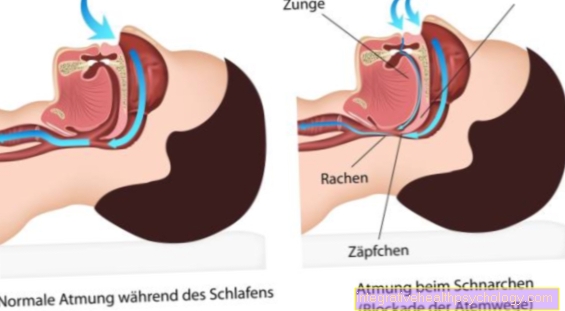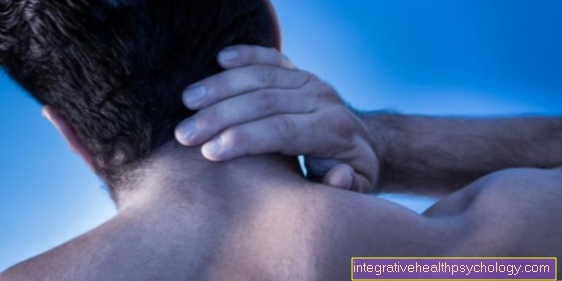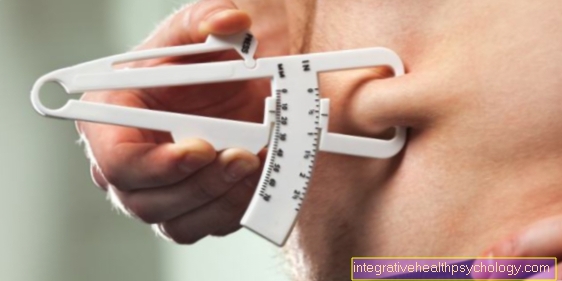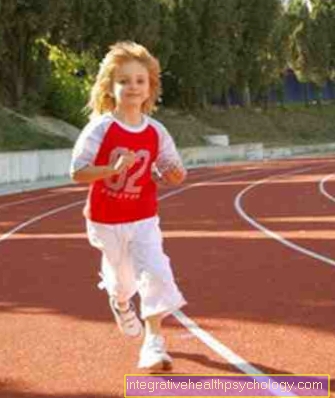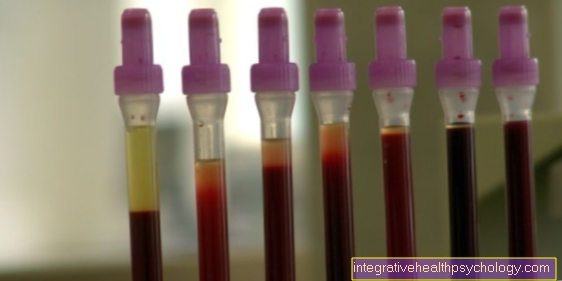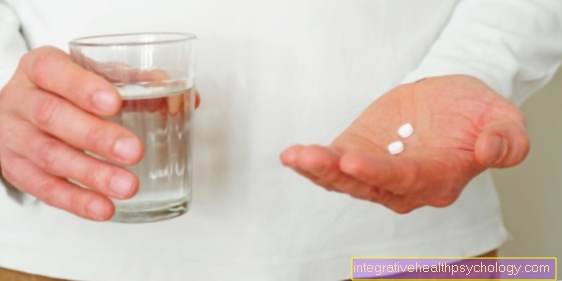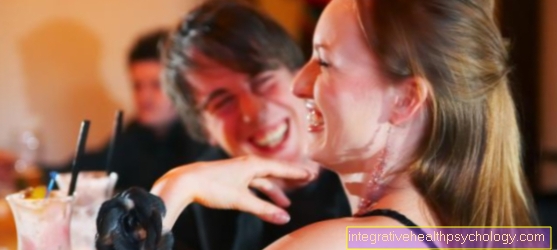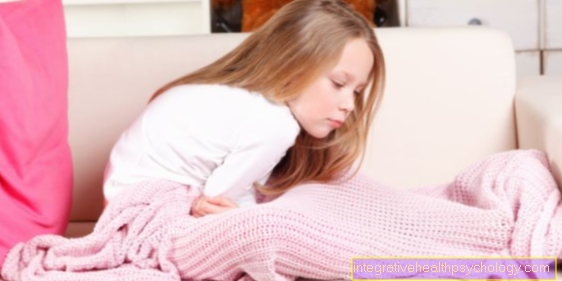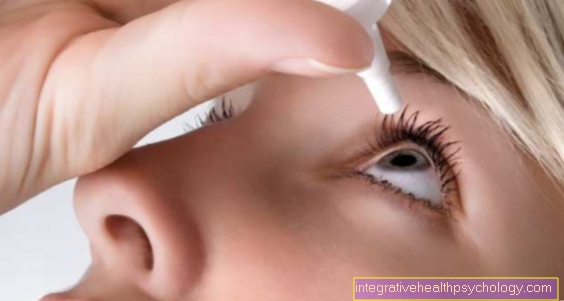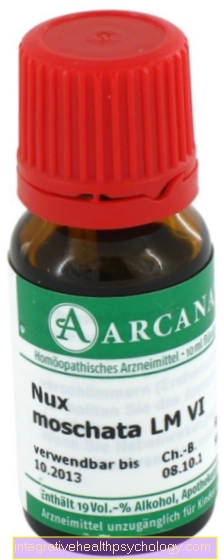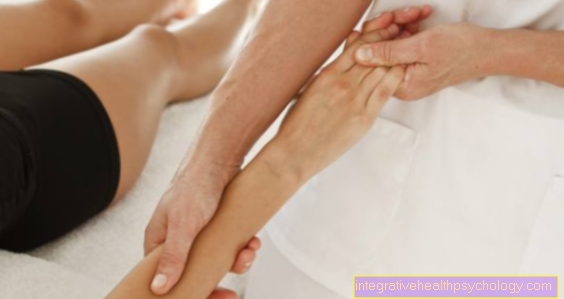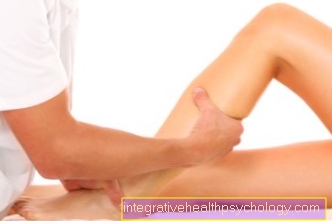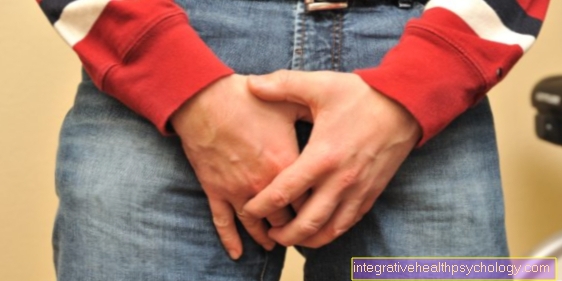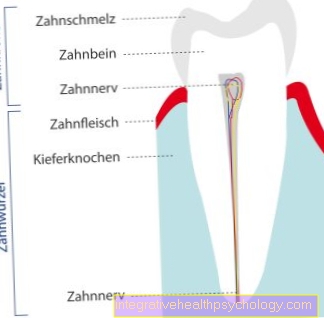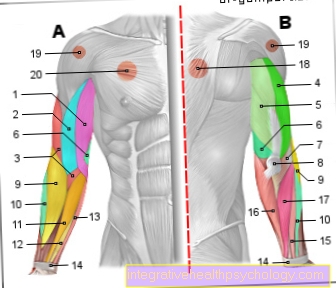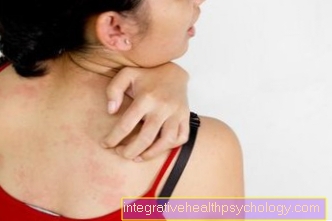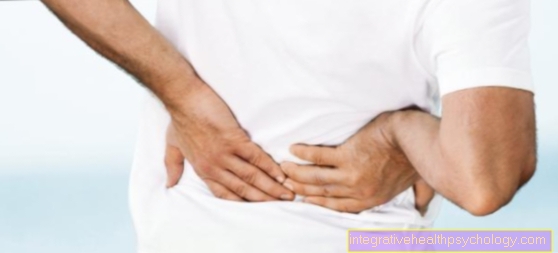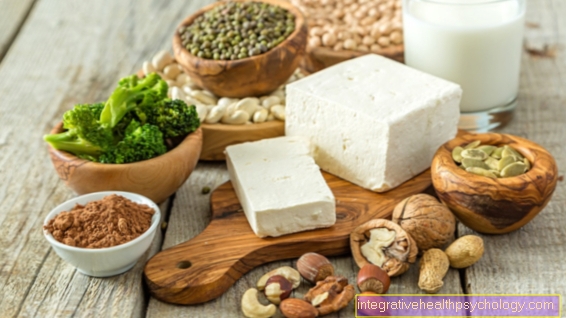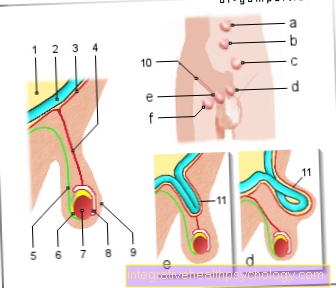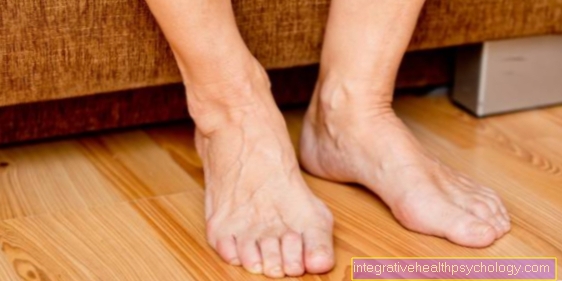Growing pains
definition
Growing pain is the term used to describe pain occurring in the lower limbs in the growth phase between the ages of four and eighteen.
The growth pain characteristically occurs in the evening hours and at night. The pain is usually brief and goes away on its own. The growth pain is not due to any injury or illness. It is an elimination diagnosis.
The cause of the growth pain is still unclear and controversial among doctors.

Symptoms
Those affected are particularly reported to have deep pain in the calves, knees, shins and thighs. In some cases the pain even occurs in the arms. The pain is characterized very differently as dull, stabbing, burning or even as cramp-like.
In addition, the pain is usually bilateral in the leg change, but not localized. The pain often travels from top to bottom or changes sides. The pain can also occur especially in the evening hours after a day of high physical exertion. The pain never occurs during physical exertion.
The pain occurs mainly in the evening and at night, but would not occur during the day. In addition, there are no further restrictions on movement during the day, it is typical that the pain is "blown away" the next morning. The pain is so severe and sudden that the affected children wake up from sleep. However, the pain subsides on its own, but can last for minutes to hours.
Short-term relief is provided by warmth or cold on the affected areas and massages. In some children a correlation with increased abdominal pain and headache is noticeable.
The physical examination did not reveal any evidence of other clinical pictures or other abnormalities. The physical development of the children proceeds according to their age, but the pain can persist for years.
The irregular occurrence is also typical for growing pain, with days, weeks or even years between the pain stages. On average, however, the pain occurs every six months. As you get older, the growing pain disappears completely.
Also read:
- Pain while growing
- Headache in child
Duration
The symptoms usually occur in children between five and ten years of age.
A pain attack usually lasts around ten to fifteen minutes, but can sometimes last for an hour. The pain usually occurs in the evening or at night. The next morning the children no longer have any complaints.
The pain attacks usually occur over a period of two weeks. After half a year there is often another period of pain. Some children experience periods of growing pains two to three times a year. After growth has been completed, growing pains definitely no longer occur.
causes
The cause of the growth pain is still unclear.
Some theories suggest that it could be a pain processing problem, resulting in a lowered pain threshold. Due to this lowered pain threshold, pain could arise even under light stress.
Another theory says that pain is caused by stretching tendons and ligaments, which do not have enough time to grow with growth spurts. The bones would grow about 0.2 mm per day, which would cause constant stretching pain from tendons and ligaments on the periosteum.
Since the growth of children can be roughly divided into three growth phases, the children grow particularly quickly in these phases, after which the pain can be particularly intense at certain phases. The legs grow particularly in large spurts, after which leg pain occurs most frequently.
Since the pain is concentrated in the night and evening hours, it is assumed that growth hormones are released during these periods, which lead to growth acceleration. In addition, bad posture, excessive mobility, excessive stress on the joints and poor blood circulation can play a role.
You might also be interested in:
- Growth spurt
- Growth hormones
Growing pains in different locations
Growing pains in the knee

If knee pain occurs as a result of growth, it usually occurs at night, so that the children may be woken up by the pain. The pain occurs mainly on the front of the knee. Sometimes the pain radiates to the thigh or lower leg. Growing pains are particularly common in active children. However, the pain never occurs during physical exertion, but always occurs at rest. Accompanying complaints such as redness or swelling are completely absent with growing pains. If the pain persists for a longer period of time, possible alternative causes should be clarified by your doctor.
These alternatives include Sindling-Larsen-Johansson disease or Osgood-Schlatter disease in the knee.
Sindling-Larsen-Johansson disease is a kneecap disease that usually occurs in boys between the ages of ten and sixteen. Due to circulatory disorders, there is pain in the lower area of the kneecap.
Osgood-Schlatter's disease is also a disease of the kneecap, which also manifests itself mainly in boys between the ages of ten and sixteen. The disease causes irritation of the kneecap tendon.
Another differential diagnosis that is initially often misinterpreted as growth pain is osteochondrosis dissecans. In the case of osteochondrosis dissecans, which among other things occurs preferentially in the knee, small bone fragments die off. These bone fragments become detached from the rest of the bone and can then lead to pain and entrapment in the joint. These joint fragments are also known as joint mice. In contrast to growing pains, there is often swelling of the knee and sudden joint blockages. As with the other diseases, young patients are also affected.
Also read: Growing pains in the knee
Growing pains in the hip
It is believed that the growing pains stem from uneven growth. Sometimes the bones, sometimes the ligaments and sometimes the muscles grow the fastest. As a result, the stress axis in the joints changes again and again, the structures that are most heavily stressed have to get used to their new stress during the growth spurt. In principle, growing pains can appear anywhere in the body, but most commonly the legs and hips are affected.
Perthes disease
To rule out growing pains of Perthes disease. It is a hip disease in children and adolescents. For reasons not yet known exactly - one suspects circulatory disorders and an imbalance of hormones - the bone on the femoral head dies. This can cause serious consequential damage. Therefore, hip pain in adolescents should not be dismissed as just growing pains. Rather, serious diseases such as Perthes' disease should be ruled out with a simple X-ray or an MRI. As with many other hip diseases, Perthes' disease can first make itself felt in the form of knee or back pain. These different structures form a functional unit and are therefore in action together with every movement. Therefore problems can spread from one joint to the other.
You can find additional information at: Perthes disease
Growing pains in the form of abdominal pain
Growing pains in children can also manifest themselves in the form of abdominal pain - or cramps. Similar to the bony skeleton, the internal organs also go through a lengthy growth process. Children often complain of oppressive, pulling stomach pains that recur every several weeks and then stop completely.
These complaints can arise as the organs grow. In the form of growth spurts, tensions and cramps often occur in the upper and lower abdomen, which cannot be localized in one place, but migrate.
Growing pains in the chest area
During the growth phase, symptoms in the chest area often arise in the form of restricted mobility or breathing, as well as muscular tension. As the bony thorax increases in size and stability over the years, the muscular structure must also be further developed.
Most adolescents describe growing pains in the chest area in the form of a stinging and pulling under the costal arch, accompanied by a restriction in breathing. As it grows, nerves are often pinched in the spaces between each rib. Above all, this causes pain that is dependent on movement and breathing, and in most cases it is perceived as very uncomfortable.
You might also be interested in:
- Pinched nerve
- Rib pain - how dangerous is it?
Growing pains in the back
Back pain can have a number of causes. On the one hand, a simple and harmless growth pain is possible, which occurs due to the uneven growth of the bones, ligaments and muscles along the spine.
However, back pain is more common due to poor posture, for example caused by growing pains in the legs. If back pain occurs in children and adolescents under the age of 18, the complaints should always be clarified in detail. A physical examination of the back, X-rays and MRIs can help rule out serious illnesses.
Also recommended: Causes of back pain
Scheuermann's disease
Scheuermann's disease is a disease of the spine.
The spine consists of many individual vertebral bones that grow together with the body over the course of the first 16 to 20 years of life. In addition, the vertebral bones initially consist partly of cartilage and partly of bone. In Scheuermann's disease, the cartilaginous parts of the vertebral bodies are so weakened that, in the course of growth (usually during puberty), strong and painful poor posture occurs in the back.
Scheuermann's disease is usually diagnosed using an X-ray. The therapy consists of physiotherapy and sports as well as a back orthosis. In rare cases, surgery is necessary.
Further important information about the disease can be found here:
- Scheuermann's disease
- Long-term consequences of Scheuermann's disease
Growing pains in the testicle
During puberty, hormonal changes trigger major growth spurts. This doesn't just affect your arms, legs, shoulders and back.
The penis and testicles grow the most, especially between the ages of twelve and fifteen. Often the two halves of the testicle do not grow evenly, so that one side of the testicle is larger and heavier than the other. This can lead to growing pains in the testicles.
Also read: Testicular pain
Growing pains in the foot
Children in the growth phases between the ages of 4 and 16 are particularly affected. Growing pains in the foot occur mainly in the evening or at night and when the body is at rest. After extensive exercise during the day, the ankle joint or sometimes even the individual toe joints often hurt.
The pain often changes and is not always located in the same place on the foot. The children complain of a feeling of pressure and can no longer perform properly. Those affected are usually symptom-free during the day. The pain is usually caused by overloading the not yet fully developed muscles and ligaments of the foot.
Köhler's disease I
Köhler's disease I is a disease of the foot. Small vascular occlusions lead to the death of the bone tissue on the navicular bone, a bone in the tarsal.
Similar to growing pains on the foot, the symptoms initially appear very unspecific and are not necessarily dependent on stress. Therefore, the actual problem, i.e. the death of the bone, is often only noticed when secondary damage such as osteoarthritis of the tarsal bone has already started. The typical age for Köhler's disease is between three and eight years. It mostly affects boys.
Köhler's disease II
As with Köhler's disease I, type II results in tissue destruction (necrosis) on bones in the foot. In Köhler's disease, however, the metatarsal bones are affected.
The cause are also the smallest occlusions in vessels, which mean that the bones are not adequately supplied with blood and nutrients. In type II, too, the symptoms such as pain are initially unspecific and only really become noticeable when the disease has progressed. In contrast to type I, Köhler's disease II mainly affects young girls.
Further information can be found here: Köhler's disease I and II
Growing pains in the heel
Growing pains in the heel area are very common. In most cases, they are only noticed in the evening when the body is at rest and can be very intense.
The heel pain, which is triggered by growth processes, never occurs during acute stress, but always as a consequence of it in phases of recovery.
Many children refuse to run completely because they can no longer step without feeling severe pain. In most cases an inflammatory change in the growth plate on the heel (apophysitis calcanei, see below) is responsible.
Heel bone growing pains (calcaneal apophysitis)
Calcaneal apophysitis is a disorder in the ossification of the growth plate of the calcaneus. The growth plate usually closes between the ages of 12 and 13.
The tension of the Achilles tendon on the heel bone plays a special role in the development of pain. The tendons and ligaments are significantly more sensitive and unstable in adolescents than in adults. When overstrained by increased physical activity or overweight, a great deal of stress is exerted on the growth plate. The children complain of swelling that exists at rest, accompanied by pressure pain in the upper area of the insertion of the Achilles tendon.
You can find additional information at: Calcaneal apophysitis
Epidemiology
Those affected are in the growth phase, which, depending on the source, can be put within a range of four to eighteen years of age.
In some cases, the pain occurs as early as two and three year olds. Girls and boys are equally affected. Depending on the population, there are frequencies of 4-37% in the population. Doctors estimate that one in three children is likely to suffer from growth pain at least once in their life.
It is suspected that certain genes are inherited in some people who may be more susceptible to experiencing growing pain.
diagnosis
The questioning of the medical history including family history is decisive for the diagnosis. A physical examination is also carried out. Through examination and questioning, the attempt is made to delimit and exclude other clinical pictures, such as other musculoskeletal diseases, which can also cause pain.
In particular, rheumatic diseases (such as juvenile idiopathic arthritis and reactive arthritis), Tumors (especially the Osteoid osteoma), Inflammation (such as that characteristic of childhood Runny nose, a harmless inflammation of the hip joint), injuries (typical in children Greenwood fracture) and blood cell disease (Leukemias).
Symptoms such as redness, swelling, localized pain, overheating indicate inflammation. Fever, night sweats, weight loss and fatigue are also serious complaints that can indicate other malignant diseases, but do not occur with growing pain.
To rule out injury, focus on bruising, redness, abrasions, and bleeding.
If questioning and physical examination are unproductive, a pain diary can sometimes be informative. In the pain diary, the pain occurring during the day and the severity of the pain are entered. You can find out whether the pain is related to certain events, such as physical stress, long periods of sitting or other events. If the pain persists for more than five days, you should see a doctor again immediately.
Depending on the results, blood tests or x-rays may be necessary. Scinitigraphy or magnetic resonance imaging are required in rare cases.
The growth pain shows no abnormalities in physical examinations, laboratory tests and x-rays.
Also read:
- Rheumatoid arthritis
- Runny nose
therapy
First, the parents are informed about what is happening and the good prospects. Because with aging, the growing pains also disappear.
As a rule, massages in circular movements and heat applications (using a heating pad, hot water bottle, warm bath) are sufficient for minor complaints. St. John's wort oil, arnica ointment or a sports ointment can be used for the massages. For some children, on the other hand, cold provides relief in the affected areas; this should be used individually depending on the child. Gentle stretching exercises can also relieve the discomfort.
Good persuasion and consolation from the parents can also induce the children to go back to sleep. It also helps children with anxiety caused by pain.
If the pain is severe and lasts for a long time, the children can also be given painkillers such as paracetamol or, depending on the age of the child, ibuprofen as a juice or suppository.
Unfortunately, there is no prophylaxis for growing pain. However, it is recommended that the children warm up sufficiently before exercise and stretch sufficiently after exercise.
homeopathy
Growing pains usually do not require any treatment, as they subside relatively quickly on their own. A causal therapy is not possible in growing pains, only symptomatic therapy. Homeopathy is used relatively often for growing pains.
It is helpful to apply heat, for example in the form of heat cushions, warm baths, but also massages, infrared radiation or so-called moor ointments often provide relief. Because warmth promotes blood circulation and can thus alleviate the pain in growing. In addition to warmth, cold is also helpful in combating pain. Depending on what is perceived as more pleasant by your child. For cold use, moist and cold compresses can be made to which a few squirts of lemon juice can be added.
The Schüßler salt Calcium phosphoricum is particularly suitable as a herbal remedy, but also Calcium carbonicum and manganum, which can be administered in the form of globules.
Rubbing or massaging the affected areas with oils also helps. St. John's wort oil is particularly popular for this, as it is able to relieve pain due to its essential components. In addition to St. John's wort, you can rub the leg with rubbing alcohol, calendula tincture or arnica ointment.
In addition to the use of homeopathic remedies, it is especially important that the child receives attention and distraction.
Growing pains in babies
Growing pains are unclear, frequently occurring non-malignant pains that occur particularly in the muscles, joints and bones.
Many toddlers often complain of pain at night and, especially in babies, these complaints can be accompanied by nocturnal restlessness and tearfulness. Babies who find it difficult to sleep, are particularly restless and do not stop crying, should always be considered about growing pains.
Growing pains in babies and toddlers tend to occur during phases when the skeleton is not actively growing. The cause can be the growth and stretching of tendons and ligaments.
As a rule, episodes of complete freedom from symptoms occur from time to time. The main pain for babies is the muscles and bones of the legs.
The first point of contact is the pediatrician, who can rule out more serious illnesses, such as tumor disease, rheumatic diseases or diseases of the bone system.
The babies' discomfort can often be alleviated by using warmth in the form of cherry stone pillows. The warmth relaxes the muscles and, in addition to relaxation, significantly alleviates the symptoms. Massage the painful area can also bring relief.
Leg pain in children
Growing pains mostly affect the long tubular bones, i.e. arms and legs, as these are more exposed to growth than other bones.
It is still largely unclear why these leg pains occur. What is certain is that growth hormones are released at night, which accelerate growth, which presumably leads to tension pain in the periosteum. This also explains why the pain mostly occurs at night. The leg pain in children usually occurs in the lower leg area. Children rarely report pain in the thigh. The growing pains are distributed rather diffusely and usually cannot be precisely localized by the children. It is also common for the pain to appear in the other leg at some point.
Read more detailed information under our topic: Leg pain in children
Growing pains in puberty
Usually the growing pains appear in elementary school age. In some cases, however, they can also extend into puberty. This is because the growing pains occur more intensely in the two major growth phases: between the fourth to sixth and ten to sixteenth years of age.
Boys in particular often have a rapid and strong growth spurt during puberty, which can lead to growing pains. During puberty, growing pains can also result from ossification that is too slow, as a sign of mechanical overstressing of a growth region.
also read: What happens in puberty?
Growing pains in pregnancy
The classic growing pains describe a pain that is mostly in the legs, less often in the arms. Most of the time, the various tissues such as bones, ligaments and muscles do not grow evenly during a growth spurt, which is why different stresses on the arms and legs occur again and again. This can cause pain in the meantime.
Growing pains do not usually occur during pregnancy, unless those affected are still growing. In this case, hormonal changes caused by pregnancy can also affect growth. In addition, both body weight and the distribution of weight on the body change, which is why joints and muscles are particularly stressed. All of this can cause growing pains in pregnant women who are not yet fully grown.
But there is another kind of harmless pain during pregnancy. This is caused by stretching the so-called mother ligaments. These ligaments are located in the pelvis and are supposed to hold the uterus there so that regardless of whether you are lying, sitting or standing, the uterus is held in roughly the same position. Because the uterus grows quickly during pregnancy, these ligaments can stretch, causing pain. The pain is harmless and should primarily be treated by rest and relaxed positioning (for example, lying on your back).
You might also be interested in: Pain during pregnancy
Growing pains associated with a fever - what can it be?
Typically, growing pains are pain that occurs primarily at night and occurs more frequently in children as part of a growth spurt. The exact cause of the growing pains is not yet clear. However, fever is usually not one of the accompanying symptoms of growing pains.
Rather, if you have fever and pain in your arms or legs, you should think of other causes: for example, the symptoms may be symptoms of flu. This leads to a fever and at the same time to limb pain and headache. Usually, in this case, children are very weak and tired for a few days. Another infectious disease such as a cold can be the cause.
More serious reasons are infections of bones or joints. These can also cause pain similar to growing pains. In addition, the body reacts with a fever in order to be able to fight the pathogens sufficiently.
Bone tumors can also cause pain and fever, but they are rare. If a child has a fever for longer than 3 days for no apparent reason and / or the symptoms occur more frequently, further diagnostics should be carried out by a pediatrician. This way, serious causes can be excluded.
Also of importance is the article: Stunted growth
Differentiation from a tumor
It is important to differentiate harmless growing pains from malignant bone tumors. Because bone tumors can cause symptoms in the bones similar to those caused by the growth of children.
If growing pains are to be clarified by the doctor, other causes such as a malignant bone tumor, a rheumatic disease or bone inflammation are always ruled out before the conclusion that growing pains are caused. The growing pains are therefore a diagnosis of exclusion.
For example, bone pain can be triggered by what is known as Ewing's sarcoma, a malignant bone tumor.
In the case of a bone tumor, however, the pain is often accompanied by swelling, in contrast to harmless growing pains. Another important distinguishing feature is that the pain mainly occurs during physical activity and regresses at night. In contrast to tumors in the spine, tumors in the thigh area in particular go unnoticed for a long time. At an advanced stage, a general feeling of malaise, fatigue, fever and weight loss often occur. Bone tumors, like growing pains, usually occur in growing age. A malignant cause should be clarified, especially if the pain is unilateral.
Osteoid osteoma
The osteoid osteoma is a benign tumor of the bone. This occurs more frequently in men than in women and has its peak between 11 and 20 years.
The bone tumor forms mainly on the long bones of the body, so the thigh bones and the lower leg bones are most often affected. The formation of new bone cells leads to an ulcer, which can cause pain. Due to the localization and the typical occurrence in adolescence, the symptoms can be mistaken for growing pains. However, the disease can be diagnosed with a simple x-ray.
Summary
In summary, it can be said that the growth pain has a very good prognosis and disappears in the course of childhood.
Pain in childhood between four and eighteen years of age, a localization in the lower limbs and an occurrence of the pain in the evening and night are characteristic of growth pain.
It is important here, however, that the diagnosis is exclusionary, whereby one must not overlook any serious illnesses or make a misdiagnosis. This makes a careful survey and physical examination all the more important. Furthermore, the cause of the growth pain is very controversial and unclear.
Warmth, massages and parental care are suitable for relieving the pain. In the case of severe pain, you can give paracetamol or ibuprofen in juice or suppository form.


